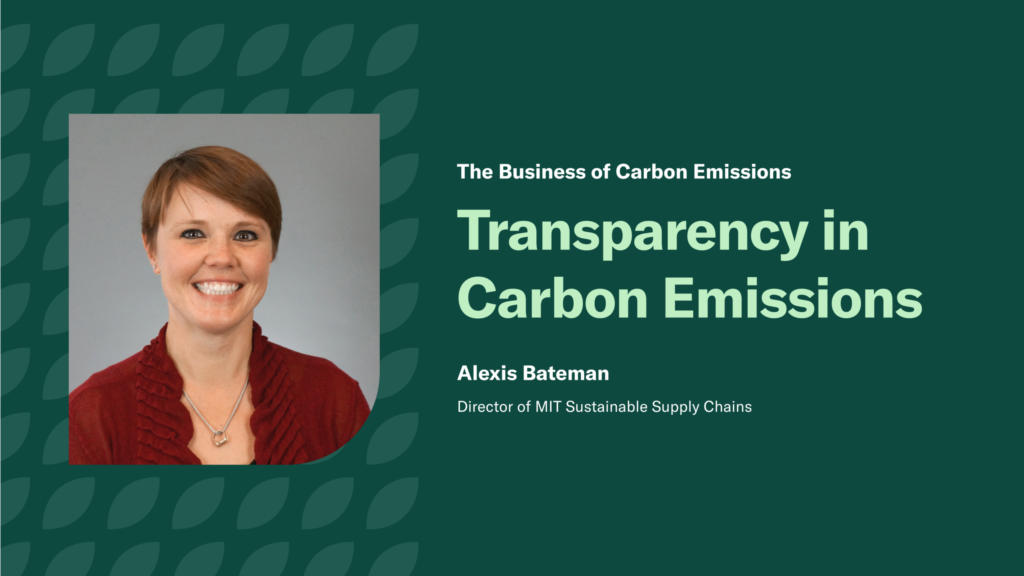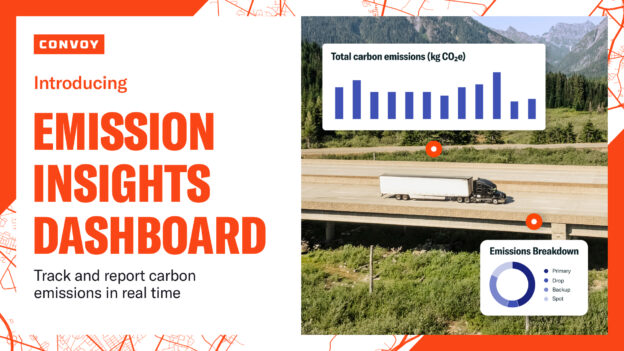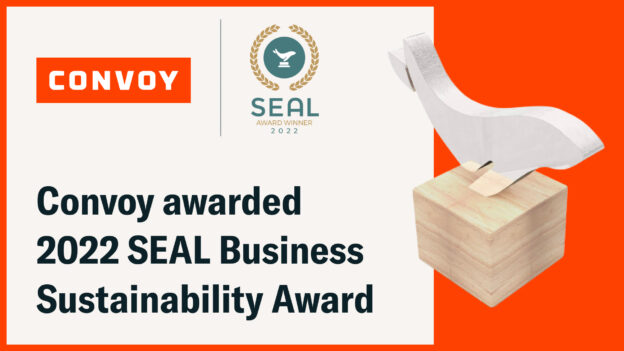Transparency in carbon emissions
Sustainability • Published on May 18, 2020

Over 86% of the S&P 500 have sustainability goals targeted at carbon emissions reduction. To make meaningful progress toward these goals, businesses need to be aligned with their entire supply chain and address carbon emissions accounting, reporting, and disclosure in partnerships with their supply chains. This is particularly relevant in the wake of current reports around working conditions, food contamination, and carbon emissions use. Consumers have become now, more than ever before, concerned about how their purchases impact their own health, their communities, and the world at large.
In our latest video about The Business of Carbon Emissions, we chat with Alexis Bateman, Research Scientist and Director of MIT Sustainable Supply Chains at MIT Center for Transportation & Logistics. Alexis Bateman is a Research Scientist and Director of MIT Sustainable Supply chains. She also serves as a course lead and instructor for the MITx MicroMasters in Supply Chain Management, a pioneering program in digital education reaching 100,000s of supply chain professionals around the world. She has over fifteen years of experience in sustainability in the public sector, industry, and academic settings. Her work focuses on supply chain sustainability through research, education, and outreach.
To help us better refine our approach to transparency in carbon emissions, we asked Alexis the following questions:
- How do you define transparency?
- How should companies choose what data to collect and what data to disclose?
- What types of questions should a business ask of their supply chain partners?
- How do visibility and transparency drive consumer trust, which in turn, drives profitability?
In addition to sharing about what she’s currently up to at MIT, Alexis provides valuable insights into data — including the collection, upload, and communication of carbon emissions results — as well as how companies determine what to share, and how these disclosures have a greater impact on consumer trust and brand value. It’s a valuable conversation to guide us all on carbon emissions disclosure going forward.
Watch now or read the transcription below.
You can learn more about The Business of Carbon Emissions and view our other videos on carbon emissions business.
Convoy provides shippers reliable, flexible, and instant capacity when they need it most. Learn more about shipping with Convoy today.
TRANSCRIPTION
Jennifer Wong: Hi everyone. My name is Jennifer. I lead sustainability at Convoy. I’m excited to announce that Convoy is hosting a series about the business of carbon emissions. You’ll hear stories, research, and innovations to learn how eliminating carbon emissions is not only good for business, but also the environment and today we’ll be diving into carbon emissions accounting, reporting, and disclosure in partnerships with your supply chains. Understanding your supply chain is more important than ever. Especially in the wake of reports around working conditions, food contaminations, and carbon emissions use. Consumers are concerned about how their purchases impact their own health, their communities, and just the world at large. In fact, 81 percent of the SMP500 have sustainability goals specific to carbon emission reductions. So, to make a meaningful impact against these goals, businesses need to be aligned with their entire supply chain. So today, we get to have Alexis Bateman here with us. She’s a research scientist and a director of MIT sustainable supply chains. She also serves as a course lead and instructor for the MIT in supply chain management. This program is a digital first program that reaches hundreds of thousands of supply chain professionals around the world. She has over 15 years of experience in sustainability and the public setter, industry, and academic settings. Her work today primarily focuses on supply chain sustainability through research, education, and outreach. So welcome Alexis.
Alexis Bateman: Thanks for having me Jennifer. Happy to join.
Jennifer: Thank you. Well, to kick things off, I would love it if you can share just a little bit more around your research work that you’re focused on today.
Alexis: Yeah, absolutely. So, I direct our sustainable supply chains initiative at the Center for Transportation and Logistics at MIT, and we try to engage supply chain sustainability in three different ways. So we do conduct research directly with industry partners, with government agencies, you know, [2:00] directly kind of real research that we see as impactful and things that we want to share broadly so that we can kind of scale the learnings beyond, you know, those one on one partnerships. So, we have, you know, applied research and then we also have an educational arm. So we teach supply chain sustainability on campus and then we’re also working on a free online course on edX that we’ll be releasing next year so we can really share those learnings to supply chain professionals and really, you know, not just supply chain professionals but really those that want to learn about supply chain sustainability genuinely. Then we have this outreach arm where it just, again, sort of putting this information out there, you know, through round tables, maybe not in person for now or in the near term but other events that we can engage everyone, you know, across different stakeholders to really make an impact and kind of share those learnings. So, we do that in three ways at, you know, the research arm, we have a few different lines that we’re working on. One is which, you know, I work heavily on transparency and visibility in the supply chain to enable supply chain sustainability. We’ve also been working with a couple partners on circular supply chains and end of life management. How we take those back and reuse, and re-manufacture, and reduce that end of life waste. You know, we have others on transportation and emissions, and carbon offsets and other opportunities to reduce the impact of logistics of freight in general. And so we have all these different research lines that we’re kind of driving forward hoping to support the industry as a whole and so we have our PHD level researchers, masters level, we engage students, you know, across all spectrums to really bring that insight from different…from engineering to urban planning to, you know, all the above. So, it’s very multidisciplinary.
Jennifer: Let’s dive into one of those topics today. Transparency. I think transparency is talked about very often in the world of sustainability as well as the supply chain, especially as there’s more technologies today [4:00] to be able to provide those types of insights. Could you just define what that means?
Alexis: Yeah. Absolutely. So, I see it as a two-part thing, transparency, which is, one, that you have that internal visibility. You’re able to access relevant information to ensure that your supply chain is, you know, functioning ethically and environmentally positive. Of course, efficiency wise, that’s always the ultimate goal. As well as doing less environmental damage. So you kind of need to know what your supply chain looks like and, you know, that was always an imperative for risk management, for optimization, for all these different drivers, but I think even now, during COVID-19 that that driver will be less than a nice to have and more of a requirement. You know, mapping your supply chain, knowing where the source of origin of your materials are, what the impact is on the ground, how you’re moving it, how it’s being shipped and then arriving at your site and then ultimately once you deliver it to your customers and consumers. So, there’s that data collection, data upload, data transfer component. How do we collect that information, how do we share it between partners, in what format, you know so that it is, you know, it’s not really, you know, as we’re all familiar with an Excel spreadsheet and shared here, and someone else edited, you know, its functional that we can use it, its scalable. So, I think that there’s, you know, quite a bit of challenge in setting up those systems in place. Everyone has their own, you know, enterprise software they use, they like to collect data in different ways. Maybe not everyone wants the same data points. So, I think there’s a lot of innovation happening there and then the other component is then, what do you disclose publicly. Right, so maybe you have a lot of internal visibility. You know, it’s not necessarily for public disclosure but some should be and is kind of being increasingly required by stakeholders. So, you know, your scope of emissions, scope one, two, and three, you know, what is the impact of emissions [6:00], how are reducing that, you know, in what timeline. What are your labor conditions, you know, a lot of, in certain industries, labor is quite a bit of a problem. You know, other environmental impacts. So, I think there’s this fine line of, you know, not disclosing too much of course but there are stakeholders looking for that information so to gather, you know, visibility and disclosure you get this transparency. It’s an evolving journey and I’m sure one that’s going to continue evolving after COVID-19.
Jennifer: And how should businesses think about what data they should be collecting and what data they want to disclose? Or I guess what insights they want to disclose. Because I do think a lot of businesses today are adopting technologies and they have a lot of data but not all data might be valuable for the kind of outcome that they want to drive.
Alexis: Yeah, absolutely. So I think, you know, I wish I had sort of the, you know, guidelines to say this is exactly what you should disclose at what point to who but I think there’s a couple of different approaches. One of which is, you know, each industry is fairly well aware of their major impacts, right. You know, obviously in transportation and shipping it’s going to be the emissions, you know, from the movement of those goods. How you’re, you know, reducing those emissions every time. So, I think that different industries can understand where their hotspots of impact are whether they be environmentally or socially. I mean, every industry has impacts across the spectrum but those that are kind of getting, you know, more scrutiny, and those that they can also address is one component that we want to understand. So many companies will go through something called a materiality assessment where they talk to, you know, they survey internally, they talk to their stakeholder, right, to understand who wants to know what. And then, obviously, they’re going to go through a process of quantifying their impacts and there’s, you know, myriad tools out there to do that and then ultimately, once they’ve been able to take action and reporting on sort of that action and the impact of that action overtime. So while I can’t say, “This is exactly what you should be reporting,” right now [8:00] but I think that understanding what the demand is, you know, making sure you’re aligning with science based targets and very informed decision making. Then you can kind of decide what should be disclosed, you know, internally to your supply chain partners and then externally to, you know, consumers and other stakeholders. So, it’s not black and white but I think once you go through that process it will be clear what is in demand.
Jennifer: Sure. And as we wrap up, one more question. So, investing in supply chain transparency can be costly, especially as you mentioned, materiality assessments. Sometimes if you work with an external partner, that can be a huge consulting fee. But it is important for companies to start making these investments because…I think in your research you’ve even tied visibility into a higher consumer trust. Could you kind of talk about how those two have been correlated or the results that you’ve seen there?
Alexis: Yeah, so there’s been different studies out there. We’ve been looking at that and, you know, in a couple different dimensions. Also, some other researchers at MIT Sloan School of Management have been looking at that as well. Which is, you know, to what extent will more disclosure on your product change buying preferences, you know. So we’re seeing, you know, it’s not always the case that they will change their buying preference but in certain cases, when quality price and other factors are held equal, the one that has more information disclosed will get purchased more on the whole. So, I think that brand recognition, that it’s a more trustworthy brand is a selling point for companies to embed more transparency. So, I think that there’s a consumer dimension component but there’s also one that I think has always been bouncing around and it’s hard to quantify, which is the risk embedded in being implicated in negative impact, right. And I think that’s true now more than ever. So, you know, that’s definitely something that’s going to be, you know, the awareness of where your products are coming from, what is the labor involved [10:00] to create, produce, move those products. That’s going to be kind of non-negotiable going forward. So I think the cost by reducing upstream impact and building, you know, downstream, you know, customer consumer trust and awareness, and, you know, acknowledge of being that kind of go-to brand, it’s going to be critical moving forward. I think that was sort of a nice to have but I think forward it’s going to be a non-negotiable.
Jennifer: Thank you so much for spending some time today.
Alexis. Yeah, absolutely. Thanks for having me.



